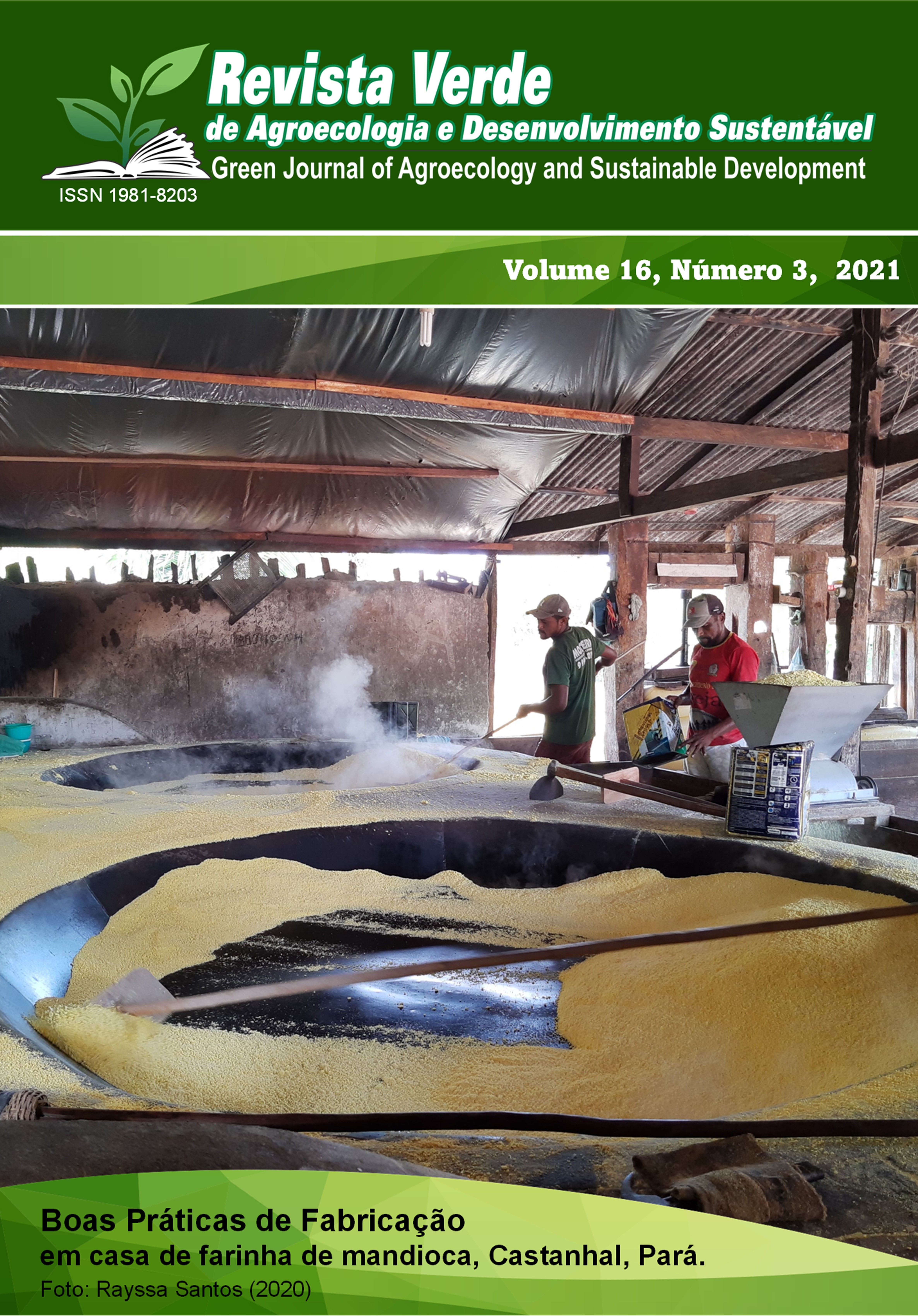Unconventional plants for food purposes sold at the fairs in São Luís, Maranhão, Brazil
DOI:
https://doi.org/10.18378/rvads.v16i3.7887Keywords:
Commercialization, Nutritional value, PANCAbstract
The research analyzed the production, commercialization and consumption of unconventional food plants (PANC) at fairs in São Luís (MA) and the chemical composition of the species Hibiscus sabdariffa L. (vinagreira) and Talinum paniculatum (Jacq.) Gaertn (joão-gome). Questionnaires were applied to three priority groups: marketers, consumers and producers, asking about their knowledge related to PANC, financial return, benefits, planting and frequency of consumption. The chemical parameters analyzed were protein, lipids, fibers, ashes, Brixº, pH, titratable acidity, vitamin C and reducing sugars following different methodologies. The results showed that in the commercial centers of São Luís, the PANC are commercialized and their benefits to health and income generation are recognized by the marketers, producers and consumers, mainly for the female gender. The main responsible for its planting and commercialization are women and the main consumers are adults and the elderly. In the vinagreira, an acidic flavor determined by high pH, titratable acidity and vitamin C was observed. The joão-gome showed little flavor, high content of Vitamin C, protein and fibers. The high protein and fiber content in both species shows the nutritional richness characteristic of PANC. Therefore, the chemical parameters of both species demonstrated the nutritional potential of these plants, justifying their wide use in cooking and traditional medicine in the region.
Downloads
References
ALETOR, O.; OSHODI, A. A.; IPINMOROTI, K. Chemical composition of common leafy vegetables and functional properties of their leaf protein concentrates. Food Chemistry, 78 (1):63-68, 2002. https://doi.org/10.1016/S0308-8146(01)00376-4.
AOAC. Official method of Analysis. 18th Edition, Association of Officiating Analytical Chemists, Washington DC, Method 935.14 and 992.24.2005.
BIASE, L. de. A condição feminina na agricultura e a viabilidade da agroecologia. Agrária,.7:4 -35, 2007. https://doi.org/10.11606/issn.1808-1150.v0i7p4-36.
BARHÉ, T. A.; TCHOUYA, G.R. F. Comparative study of the anti-oxidant activity of the total polyphenols extracted from Hibiscus Sabdariffa L., Glycine max L. Merr., yellow tea and red wine through reaction with DPPH free radicals. Arabian Journal of Chemistry,9(1):1-8. 2016. https://doi.org/10.1016/j.arabjc.2014.11.048.
BRASIL. Ministério da Agricultura, pecuária e Abastecimento. Manual de hortaliças não-convencionais. Secretaria de Desenvolvimento Agropecuário e Cooperativismo. Brasília: mapa/ACS, 2010.
BRUMER, A. Gênero e agricultura: a situação da mulher na agricultura do Rio Grande do Sul. Estudos Feministas, 12(1):205-227, 2004. https://doi.org/10.1590/S0104-026X2004000100011.
CHITARRA, M. I. F.; CHITARRA, A. B. Pós-colheita de frutos e hortaliças: fisiologia e manuseio. Lavras: UFLA, 2005, 785 p.
DA-COSTA-ROCHA, I.; BONNLAENDER, B.; SIEVERS, H.; PISCHEL, I. Heinrich, M.. Hibiscus sabdariffa L. - A phytochemical and pharmacological review. Food Chemistry, 165:424-443, 2014. https://doi.org/10.1016/j.foodchem.2014.05.002.
DOS REIS, L. F. C.; CERDEIRA, C. D.; DE PAULA, B. F.; DA SILVA, J. J. COELHO, L. F. L.; SILVA, M. A.; MARQUES, V. B. B.; CHAVASCO, J. K.; SILVA, G. A. da. Chemical characterization and evaluation of antibacterial, antifungal, antimycobacterial, and cytotoxic activities of Talinum paniculatum. Revista do Instituto de Medicina Tropical de São Paulo, 57(5):397-405, 2015. https://doi.org/10.1590/S0036-46652015000500005.
FREITAS, N. M.; SANTOS, A. M. M.; MOREIRA, L. R. de M. O. Avaliação fitoquímica e determinação de minerais em amostras de Hibiscus sabdariffa L (vinagreira). Caderno de Pesquisa, 20(3), 2013. https://doi.org/10.18764/2178-2229.v20n3p65-72.
GOMEZ, M.; LUCENA, E. A. R. M. de; MANDARINO, A. C. de S; GOMBERG, E. Emponderamento da mulher através de feiras agroecológicas na cidade de Ilhéus, Bahia/Brasil. Fórum Sociológico, 29 (29): 65-73, 2016.
INSTITUTO ADOLFO LUTZ – IAL. Métodos físico-químicos para análise de alimentos. ed. 4, São Paulo: Instituto. Adolfo Lutz, 2008,1020p.
KINUPP, V. F.; LORENZI, H. Plantas Alimentícias Não Convencionais (PANC) no Brasil: guia de identificação, aspectos nutricionais e receitas ilustradas. Instituto Plantarum de Estudos da Flora Ltda, 2014.
LIBERATO, P. da S.; TRAVASSOS, D. V.; SILVA, G. M. PANCs - plantas alimentícias não convencionais e seus benefícios nutricionais. Environmentals Smoke,2(2):102-111, 2019. https://doi.org/10.32435/envsmoke.201922102-111.
MADALENO, I. M. Plantas da medicina popular de São Luís, Brasil. Bol. Mus. Para. Emílio Goeldi. Ciências Humanas, 6(2):273-286, 2011.
MILLER, W. C.; NIEDERPRUEM, M.G.; WALLACE, J.P.; LINDEMAN, A.K. Dietary fat, sugar, and fiber predict body fat content. Journal of the American Dietetic Association, 94(6): 612-615, 1994. https://doi.org/10.1016/0002-8223(94)90155-4.
PAULILO, M. I. S. FAO, Fome e Mulheres Rurais. DADOS – Revista de Ciências Sociais, 56(2): 285-310, 2013.
PROENÇA, I. C. de.; ARAUJO, A. L. R.; TOMAZELLA, V. B.; MENDES, R. C; GOMES, L. A. A.; RESENDE, L. V. Plantas alimentícias não convencionais (PANC’s): Relato de experiência em horta urbana comunitária em município do sul de Minas Gerais. Revista Extensão em Foco, 17:133-148.2018. https://doi.org/10.5380/ef.v0i17.57880.
RIAZ, G.; CHOPRA, R. A review on phytochemistry and therapeutic uses of Hibiscus sabdariffa L. Biomedicine & Pharmacotherapy, 102:575-586, 2018. https://doi.org/10.1016/j.biopha.2018.03.023.
SILVA, C. C. da; LUCRECIA BAKOVICZ, L.; GATTI, R.R; SILVA, T.K.R; NUÑEZ, C. E. C. Percepção dos adolescentes sobre hábitos e alimentação saudáveis. Revista Adolescência e Saúde, 13(1):7-15. 2016. https://doi.org/10.1590/1413-812320152011.00972015.
SCHMEDA-HIRSCHMANN, G.; FIRESIN, G.; TAPIC, A.; HILGERT, N.; THEODULOZ, C. Proximate composition and free radical scavenging activity of edible fruits from the Argentina Yungas. Journal of the Science of Food and Agriculture, 85(8): 1357-1364, 2005. https://doi.org/10.1002/jsfa.2098.
SPANEVELLO, R. M.; GOULART, H. dos S.; LINKE, P. de. M. Trabalho feminino nas atividades agropecuárias no contexto do Rio Grande do Sul. Anais do VIII Seminário Internacional sobre desenvolvimento territorial. Territórios, Redes e Desenvolvimento Regional: Perspectivas e Desafios Santa Cruz do Sul, RS, Brasil, 13 a 15 de setembro de 2017.16p.
TOLOUEI, S. E. L.; PALOZI, R. A. C.; TIRLONI, C. A. S.; MARQUES, A. A. M. SCHAEDLER, M. I.; GUARNIER, L. P.; SILVA, A. O.; ALMEIDA, V. P de.; BUDEL, J. M.; SOUZA, R. I. C.; SANTOS, A. C dos.; SILVA, D. B.; LOURENÇO, E. L. B.; DALSENTER, P. R.; GASPAROTTO JUNIOR, A. Ethnopharmacological approaches to Talinum paniculatum (Jacq.) Gaertn. - Exploring cardiorenal effects from the Brazilian Cerrado. Journal of Ethnopharmacology,238, 2019. https://doi.org/10.1016/j.jep.2019.111873.











